
|   |

|   |
 e-mail: ukb7@rediffmail.com Mellow breeze from Manipur Photo courtesy: Guru Bipin Singh Classical Dance Forum January 19, 2018 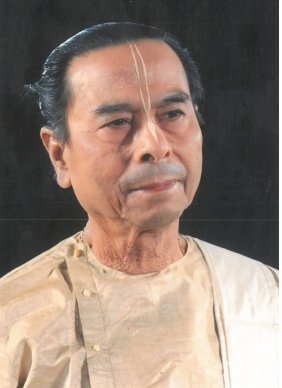 Guru Bipin Singh Is Manipur - nestling among the seven hills - - the same ancient land where the celestial Gandharvas lived and practiced their sacred songs and dance, flying frequently to heavens to entertain the gods? The inhabitants do believe still that they are the original Gandharvas and Manipur's name indeed was 'Gandharvadesh' in days of yore. Whatever the myth is, the abiding love of visual and performing arts in all rites of passage and lifestyle activities bear eloquent testimony to Manipur's aesthetic forbearers. One would love to believe that the Manipuri boy who came from the nearby Kachhar village in Assam - with dreams of dance in his eyes and a steely resolve to dance all his life despite setbacks - was perhaps a Gandharva in this birth. Groomed by stalwart gurus like Ojha Amudom Shatma, Ojha Amubi Singh and Ojha Atomba, he joined as choreographer in Madame Menaka's pioneering troupe in Mumbai in the 1930s and soon opened his own institution 'Manipuri Nartanalaya' in Mumbai, Kolkata and Imphal. His impressive repertoire of compositions was marked by the richness of taal, lyricism of music, intricacies of rhythmic patterns and fluidity of dynamic movements. How does one characterize the best of Guru Bipin Singh's choreographic oeuvre? Here is a bird's eye view as culled from two of his senior students - the dancer-duo Sruti Bandyopadhyay and Priti Patel - who, together, once made waves in this land and overseas and still, on their own, carry his glorious torch. One, when the dance scene was filled with luscious group compositions, he innovated the solo format in Manipuri a la Bharatanatyam and other classical styles, and often choreographed them around his own students' abilities. Damodar Singh of the State Kala Academy arranged the first solo Manipuri festival. Two, he clearly demarcated lasya and tandava in the Manipuri format and defined their exposition for Radha and Krishna in Raas Lilas. Three, he freely borrowed idioms from Pung Cholam, Kartal Cholam, Udukhal Raas, Gopi Raas and such others to create new dance expressions for his disciples. Four, his range of the rhythmic patterns was immense from four to fourteen beats - punctuated by stressed spaces - and he dug deep into the Manipuri ethos to come up with intricate rhythm combinations. And five, he blended many features of both Lai Haraoba rituals (like the Meite Pranam) and Thang Ta postures (like the sword-wielding) into the dancer's gestural language to enhance the latter's quality and reach. It is well-known that the 1778 foundation of Govindaji temple by the King Bhagyachandra, followed later by revival of Raas Lilas (like Maha Raas, Vasanta Raas, Kunja Raas, Nitya Raas, etc.) injected the sinews of physical movements into Manipuri dance. The spread of Vaishnavism in Manipur inspired to source its contents from Srimadbhagavad, especially from its Chapters 23 and 24. An inquiry into the kinaethetics of Manipuri dance reveals some fascinating features. The style, as practiced today, draws inspiration, no doubt, from Lai Haraoba, Sankirtan, Raas Lila and Thang Ta, yet it retains its unique beauty and integrity. From Lai Haraoba, some Maibei Jagoi movements have seeped into this style, such as, khujen (movement of hand) and Thong Leitang (movement of sword). From Sankirtan has come Mukna (the art of wrestling). Raas Lila used to be primarily lasya of female dancers as Gopis around the static idol of Krishna, while Manipuri style evolved to have both Radha and Krishna as dance-partners. Sankirtan has gifted a myriad taals, including Kunji, Kankan, Tanchep, Meikup (comparable to Dadra) and Brahma Taal (28 beats). Khurmjari presented by Guru Bipin Singh Classical Dance Forum showcased items that were his handiwork on January 9 and 10, 2018 as a tribute in his birth centenary year. Established by senior disciples of Guru Bipin Singh from India and abroad, GBS-CDF held aloft some gems of their guru's handiwork on both days. Confining this critic's attention to the first day alone, the seniors displayed his legacy through solos and small group compositions. The programme began picturesquely on the ICCR foyer with both days' female dancers paying homage to their guru's image and trooping into the hall in a colourful dance procession, accompanied by Pung. Mangalacharan was an overture then by the entire group of dancers, with an invocation to Krishna narrating his beauty and was followed by a Prabandha using Tenaka: dim, tom, dena, tana... 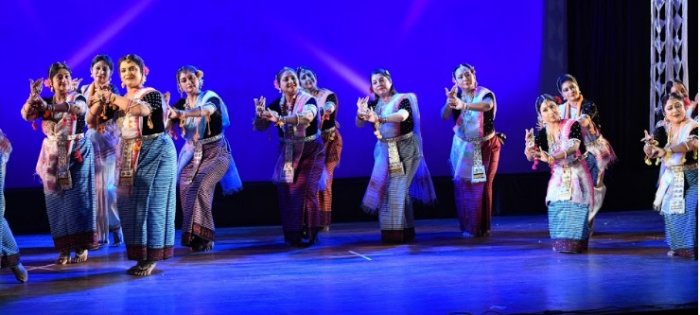 Mangalacharan 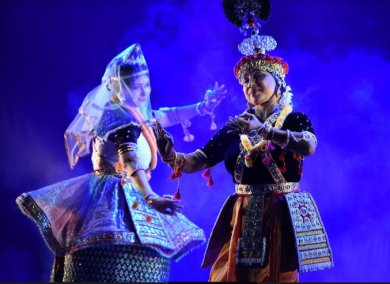 Jugal Nartan 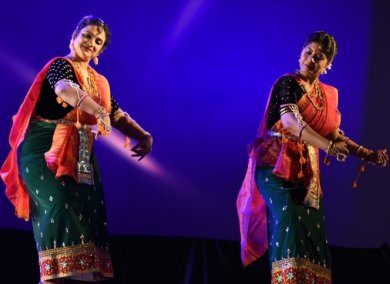 Pantha Jagoi 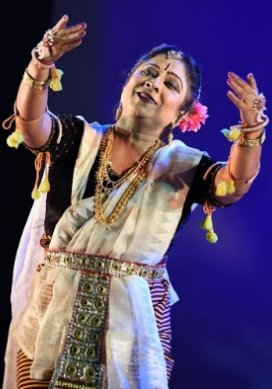 Soma Roy 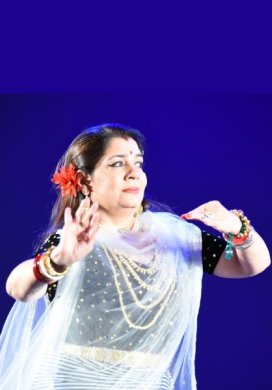 Priti Patel 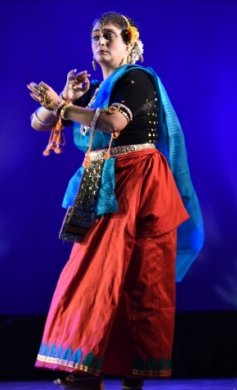 Poushali Chatterjee Jugal Nartan came then with a duet by Kuhelika Basu and Rikhia Basu where Krishna and Radha perform together demonstrating their enduring amour through tandava and lasya respectively. In its wake, Manini Radha was another solo - by Soma Roy - where Radha sets out in the dead of the night to meet Krishna, but is disappointed when he fails to turn up at the appointed hour. Almost to pinpoint Manipuri dance's enduring fount head of Raas Lilas, Pantha Jagoi was a sequence from Nritya Raas. Here Radha and Krishna are seen competing with each other and bringing out picturesquely tandava and lasya once again. Its special feature was its intricate rhythmic structure in Teora taal and use of tandava and lasya to compete with - - rather than supplementing - - each other. Nilanjana, Purbita, Rikhia and Indrani made an eye-filling foursome. A highlight of the evening was the post-interval Pung Vadan by the dancer trio Latasana Devi, Srabani Samanta and Poushali Chatterjee. As a very refreshing approach, Guru Bipin initiated his female disciples into the erstwhile male domain of Pung and the celebrity Manipuri dancer Darshana Jhaveri, played the accompanying big cymbals, insisting to remain standing despite her advancing age. The synchronised percussion ensemble was a treat for both the eyes and the ears! 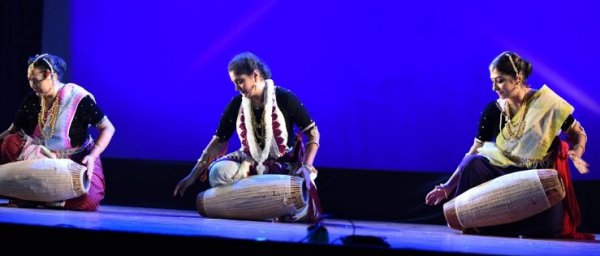 Mridang vadan 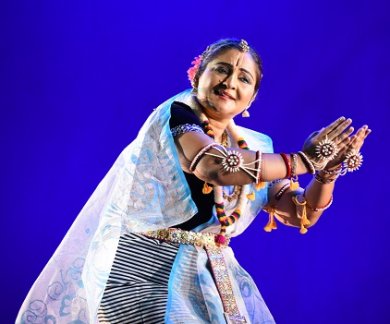 Sruti Bandyopadhyay 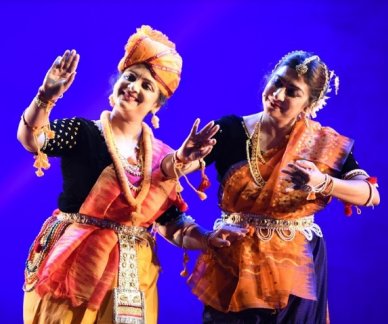 Manbhanjan by Indrani Basu as Krishna and Srabani Samanta as Radha 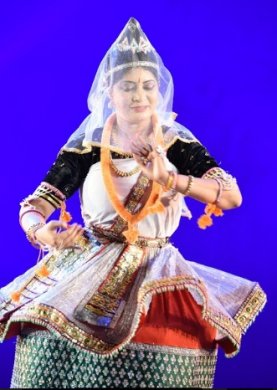 Rikhia Basu 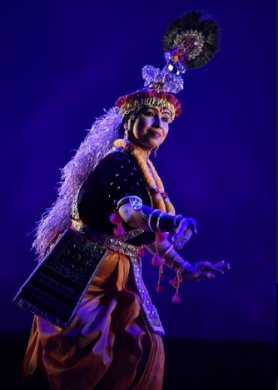 Kuhelika Basu 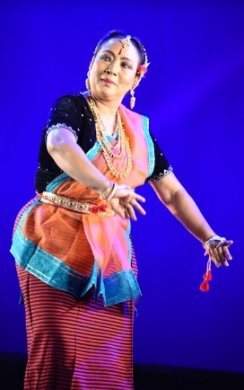 Latasana Devi The eighth item was Swara Prabandha, a distinctive choreography by Guru Bipin executed by Sruti Bandyopadhyay. Marked as a dance by the principal sakhi Lalita, this item uses nritta (pure dance) called Chhara sans taal, typical of Manipuri dance. Set to raga Bhupali and Khunji taal, it also uses swara (melodic notes), and was a delight to watch. Manbhanjan, based on multiple ashtapadis from Jayadeva's Gita Govinda, was elaborately woven around Radha's encounter with Krishna, after he makes an appearance with tell-tale signs of spending the night with another diva and concluded with his appeasement in a lyrical surrender to Radha: Twam asi mama bhushanam, twam asi mama jeevanam, twam asi mama bhava-jaladhi-ratnam... The dancers, Sarbani Samanta and Indrani Basu, gave a good account of themselves. Krishna roop Varnan was the penultimate item where Latasana Devi described the divine beauty of Krishna based on the unusual taal Kankan of 11 beats. The finale was Khubakishei, a resplendent clap dance - with all the dancers joining in - in a virtuoso choreography. Performed during Ratha Yatra by both male and female dancers, the clap dance created the metaphors of Jayadeva's Dashavatar. A very satisfying experience, on the whole, put up by senior disciples coming together to pay homage to a legendary guru.  Dr. Utpal K Banerjee is a scholar-commentator on performing arts over last four decades. He has authored 23 books on Indian art and culture, and 10 on Tagore studies. He served IGNCA as National Project Director, was a Tagore Research Scholar and is recipient of Padma Shri. Post your comments Please provide your name and email id when you use the Anonymous profile in the blog to post a comment. All appropriate comments posted with name & email id in the blog will also be featured in the site. |